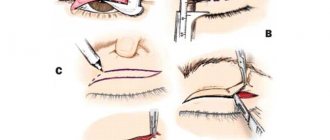Plastic surgery has become increasingly popular in recent years. Few people know exactly how it differs from reconstructive surgery. However, if you decide to change something about yourself in this way, then first you should figure out what the reconstructive surgery will look like and what exactly it is needed for.
What is reconstructive plastic surgery?
It is used to recreate or restore the shape or functionality of a specific body part or organ (such as the lower leg). Unlike conventional plastic surgery, such an operation is more needed by people with congenital changes or those who have serious consequences after injuries.
With this type of plastic surgery, the necessary material is transferred from another area. It is taken from the same patient. The necessary tissues can also be taken from another person if they are compatible. Often special implants are used to replace the necessary material.
This operation can be performed on any part of the human body. Therefore, it can be performed by surgeons with any specialty. Not only a plastic surgeon, but also a gynecologist, for example, can perform the procedure. It all depends on the area where plastic surgery is planned.
In order to better understand what this type of operation is, it is necessary to note the main differences between plastic surgery and it. In fact, reconstructive is a subtype of plastic. There are several conventional divisions of this area of surgery. Reconstructive plastic surgery can be performed for aesthetic purposes, such as umbilicoplasty. In this case, the operation is prescribed due to the initiative of the patient himself, who wants to improve the shape of the body or face for an aesthetic effect. The purpose of the procedure may be reconstruction when the operation is performed for medical reasons. However, there are no serious distinctions between the listed subspecies. After all, it includes elements of improvement, aesthetics, and vice versa.
TOP 5 clinic doctors
A team of first-class specialists works to correct the appearance of patients at the medical center:
- Gogia B. Sh. – Head of the Department of Plastic Surgery, Doctor of Medical Sciences. He is a member of the Russian Society of Surgeons, the Russian and European Associations of Herniologists (specialists in the treatment of hernias), as well as the European Association of Endoscopic Transluminal Surgery. Badri Shotaevich has repeatedly trained abroad (London, Paris, Lille, Strasbourg, Vienna). He specializes in hernia repair operations, a wide range of interventions on the body, as well as breast reconstruction after mastectomy. Awarded the “Excellence in Healthcare” badge.
- Alyautdinov R.R. – senior researcher, candidate of medical sciences, plastic surgeon. Specializes in operations on the mammary glands, abdominal wall, upper and lower extremities, as well as liposuction. He is a member of the Russian Society of Plastic Surgeons, the Russian and European Communities of Herniology. He is the holder of a patent for an invention and the author of more than 100 scientific papers.
- Sultanova N. O. – surgeon, candidate of medical sciences. Naida Osmanovna specializes in plastic and maxillofacial surgery, as well as oncology. Performs all types of facial rejuvenation operations, and also has certificates for botulinum toxin injections. Member of ROPREH and the Society of Surgeons of Russia. Author of more than 90 scientific publications.
- Kopyltsov A. A. – research fellow of the department, candidate of medical sciences. Performs surgeries for correction of mammary glands, plastic surgery of the face and eyelids, abdomen, thighs and legs, liposuction, as well as removal of hernias and soft tissue tumors.
- Ukhin S.A. is an excellent surgeon in the field of reconstructive plastic surgery. Graduated from the State Medical University.
Facial reconstruction
Reconstructive facial plastic surgery is needed when it is necessary to eliminate the consequences of burns, operations or serious injuries, remove birth defects, etc. Facial reconstruction is necessary to restore or recreate tissue or organs in the area that have been damaged. For example, after a burn, a skin graft is performed.
The material is taken from the same person, but from a different part of the body, and transplanted onto the facial part. Otoplasty is performed as part of reconstructive surgery. It consists in the fact that doctors restore the shape in the ear area. Lip plastic surgery is performed to restore their shape or size, the deformation of which occurred as a result of a burn or injury.
Blepharoplasty is also performed. This is eyelid plastic surgery, which can correct the eyelids in various ways, change their shape, the shape of the eyes, and get rid of imperfections. In particular, this applies to age-related changes, when excess fatty tissue and skin on the eyelids are removed. In the same way, you can correct the negative consequences of paralysis or injury.
Types of plastic surgery of the face and neck
Correction of the appearance of the face and neck is the most popular service in plastic surgery. This is a collective term that includes several types of surgical interventions.
Frontoplasty
This is the name of a complex of surgical measures aimed at correcting the shape and getting rid of cosmetic effects in the forehead and brow ridges. Frontoplasty is an operation that is performed for aesthetic reasons, with the purpose of rejuvenation. There are no serious diseases or problems in this area that would force one to prescribe this type of plastic surgery for health/medical reasons.
Frontotemporal lifting
The operation can be performed to reduce or increase the height of the forehead, but more often manipulation is used when it is necessary to rejuvenate the upper third of the face - smoothing longitudinal and transverse wrinkles, drooping of the outer corners of the eyes and the brow ridge.
The duration of the procedure is about 2 hours, the patient must first undergo a full examination to exclude contraindications, since he will be given general anesthesia. Among the additional examination methods, it is worth highlighting computed tomography with the study of anthropological data - the doctor must know the thickness of the frontal bone, the exact location and size of the frontal sinuses.
Before surgery (A) and 6 months after frontotemporal lifting (B)
Rehabilitation after frontoplasty can last for 30 days; for the first 2 weeks, swelling of the upper part of the face remains, and hematomas may be present. The patient must follow the classic rules of the recovery period - avoid direct sunlight, do not visit solariums, and do not perform thermal procedures.
For 3 days after surgery, it is forbidden to wash or comb your hair. All unpleasant sensations (pain, feeling of pressure in the eyes) are relieved with analgesic drugs.
We recommend reading about the technique of frontoplasty. From the article you will learn about indications and contraindications for surgery, preparation for frontoplasty, stages and results of the operation. And here is more information about cheekbone plastic surgery.
Cheiloplasty
A set of measures aimed at improving the appearance of the lips, paralabial space and nasolabial space. Cheiloplasty is considered one of the simplest operations in facial plastic surgery; most often, hospitalization of the patient is not required, and the entire procedure is performed under local anesthesia.
This type of procedure is indicated for:
- age-related changes in lip shape;
- drooping (ptosis) of the corners of the mouth;
- too much distance between the upper lip and nose (anatomical feature);
- narrow, thread-like lips.
Lips before and after the “Bulhorn” operation
Cheiloplasty is often required to hide scars in the lip area left after operations or injuries. This type of plastic surgery includes not only surgical intervention, but also specific cosmetic procedures. Rehabilitation after surgery lasts only 2 weeks, during which it is forbidden to consume hot food, ice-cold drinks, or eat solid foods.
Swelling and hematomas disappear within 2-4 days after surgery; the patient must undergo a short course of antibacterial therapy; the doctor can individually prescribe anti-inflammatory drugs and, if necessary, analgesics.
Watch this video about how cheiloplasty is performed, the recovery period and the result:
Mandibuloplasty
This is the name for facial correction in the lower jaw area, which is most often carried out in combination with genioplasty - work on the chin. Such interventions allow not only facial rejuvenation, but also correction of congenital defects in the anatomical structure of the lower part of the face or acquired asymmetry. Most often, such manipulations are prescribed not only for aesthetic reasons, but also for:
- deformation of the edge of the lower jaw;
- chin defects;
- malocclusion.
Preparation for the operation is classic - visiting the surgeon to outline the scope of future work, undergoing a full examination. Mandibuloplasty is considered a rather complex surgical procedure, and therefore the rehabilitation period is long – at least 2 months.
For the first 3 weeks, the patient will be bothered by swelling, hematomas, pain, and a feeling of numbness - these are all temporary complications that disappear on their own as they recover. To alleviate the condition, the patient is prescribed painkillers, anti-inflammatory drugs, and cold compresses.
It is impossible to say exactly when the recovery will end, since it depends on several factors - how much work was done by the surgeon, how correctly the rehabilitation is carried out, whether there are any common chronic pathologies, how strong the patient’s immunity is.
Watch this video on how to enlarge your chin:
Blepharoplasty
Perhaps the most popular service in plastic surgery clinics is eyelid correction, which is performed to rejuvenate and improve the aesthetic appearance of the upper and central part of the face. Indications for blepharoplasty are not only the patient’s own desire, but also:
- excessive pigmentation of the skin in the designated area of the face;
- tear trough is too deep;
- widening of the lateral corners of the eyes;
- intensely defined eyelid-buccal groove;
- wrinkles, dark circles and bags under the eyes.
Blepharoplasty of the lower eyelid
The operation is performed under general anesthesia, but if the surgeon’s work is limited to a small volume, then it is possible to use local anesthesia in combination with sedatives. Rehabilitation is fast - 4 hours after the intervention, the blindfold is removed from the eyes, and a day later the patient is discharged for an outpatient recovery period.
Within 1 week, swelling, persistence of hematomas, and pain in the surgical area are possible. Ointments, creams, and eye drops help speed up recovery—these medications are prescribed by an ophthalmologist.
In addition, as part of plastic surgery of the face and neck, the following are performed:
- rhinoplasty – nose correction;
- otoplasty – work on the shape and size of the ears;
- removal of Bisha's lumps - located in the upper part of the cheeks;
- malarplasty - reducing or increasing the volume of the cheekbones, correcting their shape, creating complete symmetry;
- neck lift, or circular lift;
- platysmoplasty – getting rid of sagging neck bands, which is a sign of aging.
Breast reconstruction
Such operations in this area can be carried out not only for cosmetic, but also for therapeutic purposes. Breast surgery is prescribed for:
- birth defects;
- funnel chest;
- getting injured or;
- undergone surgery.
Plastic surgery can be performed for musculoskeletal and bone surgery, which normalizes the functioning of the respiratory system and improves the cardiovascular area. Also, with the help of such an operation, you can restore the correct appearance of the body.










